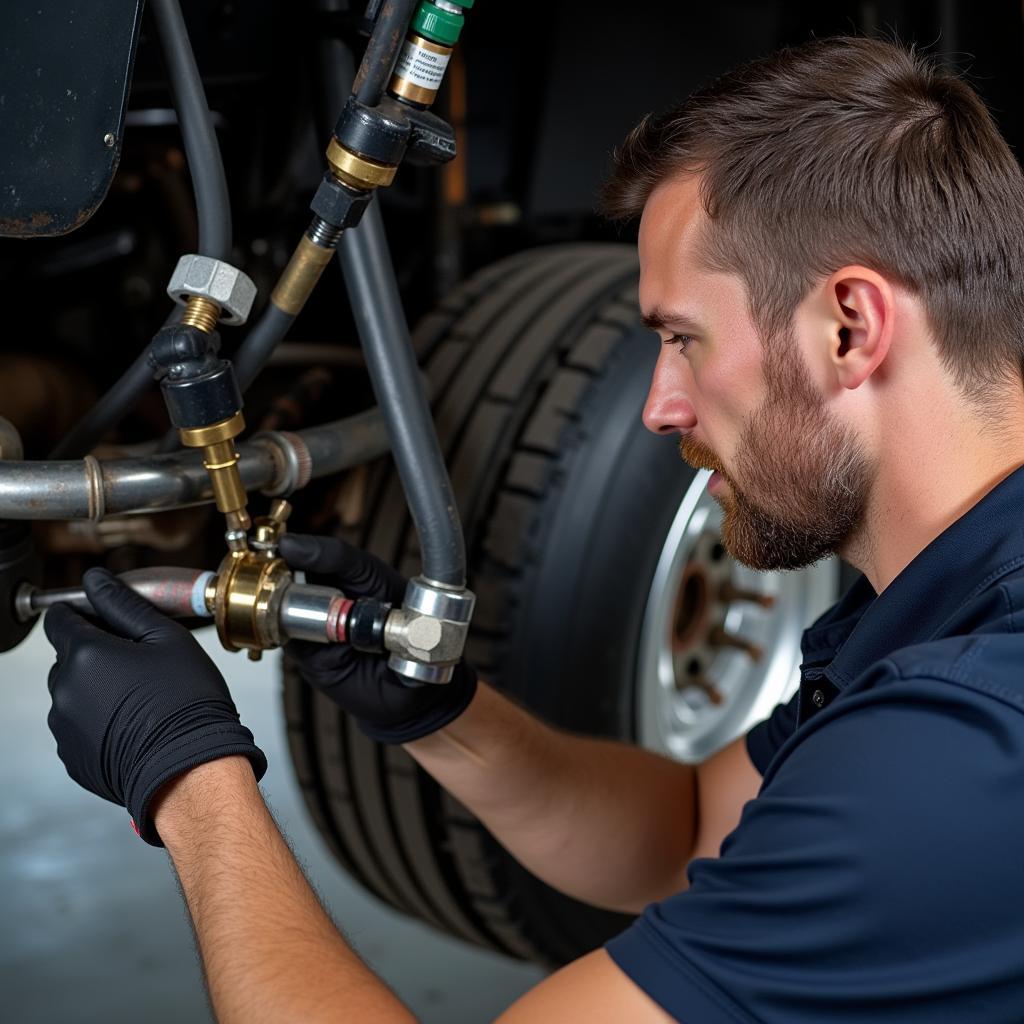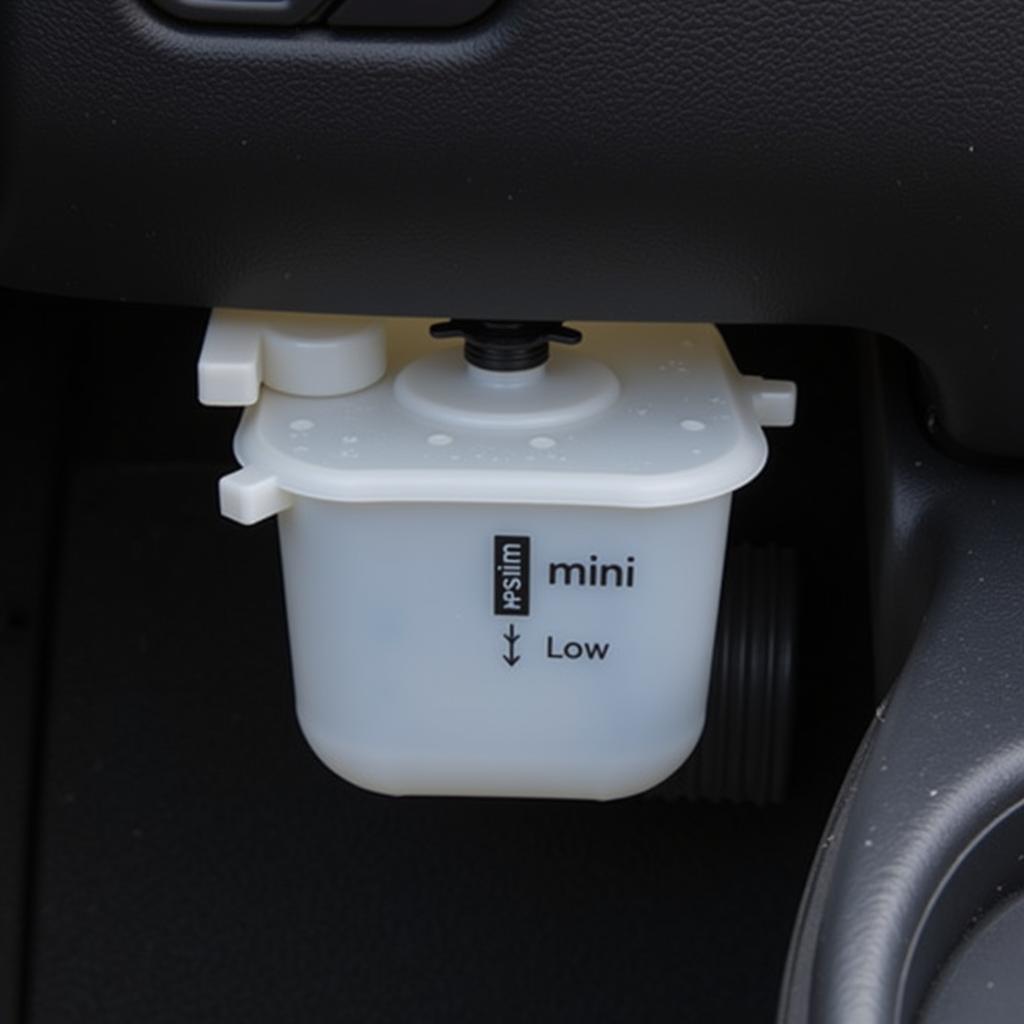The air brakes warning light on your dashboard is a crucial safety feature, alerting you to potential problems within the air brake system of your vehicle. When illuminated, it indicates that the air pressure in the system is below a safe operating level. This could be due to various factors, ranging from minor leaks to more serious component failures. Ignoring this warning light could lead to reduced braking efficiency and potentially dangerous situations. This comprehensive guide will delve into the common causes of low air brake pressure and provide practical steps for diagnosing and addressing the issue.
Understanding Your Air Brake System
Before diving into troubleshooting, it’s helpful to understand the basic components and functionality of an air brake system. Unlike hydraulic brakes that use fluid, air brake systems utilize compressed air to transmit force to the brake chambers, ultimately stopping the vehicle.
A typical air brake system consists of:
- Air Compressor: Driven by the engine, this component pumps air into the system.
- Air Dryer: Removes moisture from the compressed air to prevent corrosion and freeze-ups.
- Reservoirs: Storage tanks for the compressed air.
- Brake Valves: Control the flow of air to different parts of the system.
- Brake Chambers: Convert air pressure into mechanical force to apply the brakes.
Common Causes of Air Brakes Warning Light Activation
While a low air pressure warning might seem straightforward, numerous factors can trigger the air brakes warning light. Here are some of the most common culprits:
1. Air Leaks
One of the most frequent causes is air leaks within the system. These leaks can occur at various points, including:
- Hose Connections: Loose or damaged hoses are common culprits.
- Air Compressor: Worn piston rings or seals in the compressor can lead to air loss.
- Air Dryer: The purge valve on the air dryer can malfunction, causing leaks.
- Brake Valves: Worn seals or diaphragms in brake valves can also contribute to pressure loss.
2. Faulty Air Compressor
The air compressor is the heart of your air brake system, and if it fails to generate sufficient pressure, the warning light will illuminate. Common compressor issues include:
- Worn Compressor: Over time, the internal components of the compressor can wear down, reducing its efficiency.
- Faulty Unloader Valve: The unloader valve regulates air pressure, and a malfunction can prevent the system from reaching optimal pressure.
3. Brake Adjustment Issues
Improperly adjusted brakes can also lead to low air pressure warnings. If the brake shoes are not adjusted correctly, they may not make proper contact with the drums, leading to excessive air consumption and triggering the warning light.
4. Malfunctioning Air Dryer
The air dryer plays a vital role in removing moisture from the compressed air. A malfunctioning dryer can lead to several issues, including:
- Frozen Air Lines: Moisture in the system can freeze in cold temperatures, blocking airflow and activating the warning light.
- Corroded Components: Over time, moisture can corrode internal components, leading to leaks and reduced system efficiency.
Troubleshooting Air Brakes Warning Light Pressures
When the air brakes warning light illuminates, it’s crucial to diagnose and address the issue promptly. Here’s a step-by-step guide to help you troubleshoot the problem:
1. Check the Air Pressure Gauge:
- Locate the air pressure gauge on your dashboard. It typically displays the pressure in both the primary and secondary air tanks.
- If the pressure is below the recommended level (usually around 100-120 PSI), it indicates a problem within the system.
2. Listen for Air Leaks:
- With the engine off, carefully listen for any hissing or whistling sounds, which could indicate an air leak.
- Pay close attention to hose connections, the air compressor, the air dryer, and brake valves.
- Using soapy water on suspected areas can help pinpoint leaks, as escaping air will create bubbles.
3. Inspect Air Lines and Connections:
- Visually inspect all air lines and connections for signs of damage, cracks, or loose fittings.
- Pay close attention to clamps and ensure they are tight and secure.
4. Check the Air Compressor:
- With the engine running, observe the air compressor to ensure it’s pumping air and the pressure gauge is rising.
- If the compressor is not building pressure or takes an unusually long time to reach operating pressure, it may need to be inspected or replaced.
5. Inspect the Air Dryer:
- Check the air dryer for any signs of moisture or leaks.
- Verify that the purge valve is functioning correctly and not stuck open.
6. Check for Brake Adjustment Issues:
- Inspect the brake shoes to ensure they are adjusted correctly and make proper contact with the drums.
- If adjustments are needed, consult a qualified mechanic or refer to your vehicle’s service manual.
 Mechanic Inspecting Air Brake System
Mechanic Inspecting Air Brake System
When to Seek Professional Help
While some air brake issues can be addressed with basic troubleshooting, it’s essential to seek professional assistance if:
- You are uncomfortable or unfamiliar with working on air brake systems.
- You cannot locate the source of the problem.
- The issue persists after basic troubleshooting.
Air brake systems are critical safety components, and attempting repairs beyond your skill level could worsen the problem or create hazardous driving conditions.
Preventive Maintenance for Air Brake Systems
Regular maintenance can help prevent air brake problems and ensure the system’s longevity. Here are some essential preventive maintenance tips:
- Daily Air Tank Drain: Drain the air tanks daily to remove accumulated moisture, especially in humid or cold climates.
- Regular Inspections: Conduct regular visual inspections of air lines, connections, and components for signs of wear, damage, or leaks.
- Periodic Component Replacement: Replace air dryer cartridges, hoses, and other components as recommended by the vehicle manufacturer or at the first sign of wear.
- Professional System Check: Have the entire air brake system professionally inspected and serviced annually or as recommended by the vehicle manufacturer.
Conclusion
The air brakes warning light is a crucial safety feature that should never be ignored. By understanding the common causes of low air pressure and following the troubleshooting steps outlined in this guide, you can address the issue promptly and ensure the safe operation of your vehicle. Remember, regular maintenance and timely professional inspections are essential for preventing air brake problems and ensuring the longevity of this vital system. If you encounter persistent issues or are unsure about any aspect of air brake repair, always consult a qualified mechanic for expert assistance.
Frequently Asked Questions
1. Can I drive my vehicle with the air brakes warning light on?
It is strongly advised not to drive your vehicle with the air brakes warning light illuminated. This indicates a problem with the air brake system, which could lead to reduced braking efficiency and potentially dangerous situations.
2. How often should I drain my air tanks?
It’s recommended to drain your air tanks daily, especially in humid or cold climates, to remove accumulated moisture and prevent corrosion or freeze-ups.
3. How long does an air compressor typically last?
The lifespan of an air compressor varies depending on usage and maintenance. However, with proper care, they can last for several years or hundreds of thousands of miles.
4. How much does it cost to replace an air compressor?
The cost of replacing an air compressor can vary significantly depending on the make and model of your vehicle and the labor costs in your area. It’s best to contact a qualified mechanic for a quote.
5. What is the purpose of the air dryer in an air brake system?
The air dryer removes moisture from the compressed air, preventing corrosion within the system and ensuring optimal performance in cold temperatures.
6. Can I use any type of air hose for my air brake system?
No, it’s crucial to use air hoses specifically designed for air brake systems. These hoses are designed to withstand high pressures and meet specific safety standards.
7. How can I tell if my brake shoes need adjustment?
If you hear a squealing noise when braking or experience a spongy brake pedal, your brake shoes may need adjustment. It’s best to have them inspected by a qualified mechanic.

